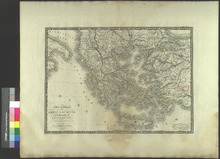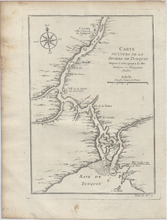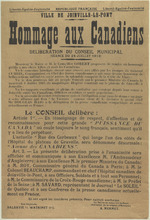This is a copper engraved map of Ancient Greece and Turkey from 1822 by Adrien Hubert Brue. The title of the map is Carte generale de la Grece Ancienne et D'ne Partie de Ses Colonies, par A.H. Brue, Geographe de S.A.R. Monsieur. A Paris, Chez l'Auteur, rue des Macons-Sorbonne, no. 9, et chez les principaux marchands de geographie. Aout 1822. This roughly translates to General Map of Ancient Greece and Some of Its Colonies, by A. H. Brue, Geographe S. A. R. sir. In Paris at Rue des Macons-Sorbonne, No. 9 and at major geography merchants. August 1822. Countries appearing on this map: Greece Cities appearing on this map: Greece: Island of Crete: Cisanuis (?), Coricus (?), Aptera (Destroyed by an Earthquake in the 7th Century), Polyrrhenia, Cydonia (Kydonia, abandoned after the 13th Century), Amphimalia (Amphimalla, abandoned), Phenix (?), Pantomatrium (?), Miletus (?), Rhitymna (Rethymno), Eleutherna (Abandoned in the 16th Century), Dium (?), Cylaeum (?), Cnossus (Knossos, abandoned 1100 BC), Methymna (?), Assus (?), Phaetus (?), Gortyna (Gortyn, destroyed in 828), Inathus (?), Heracleum (Heraklion), Lyctos (Lyctus, abandoned by the 16th Century), Minoa (?), Arcades (?), Hyerapytna (Ierapetra), Blenna (?), Prasos (Praisos), and Nanus (?). Island of Karpathos: Nisyrus (?) and Posidium (?). Peloponnese: Messenia: Pylus (Pylos), Methone (Methoni), Asine (Abandoned), Corone (Koroni), Stenyelaeus (?), Ahia (?), Pharie (?), Aetylus (?), Thalamie (?), Laconia: Baea (Boeae), Asopus (Asopos), Leucaae (?), Epi Delium (?), Epidaurus Limera, Geronthae (?), Maryos (?), Chorion (?), Magonia (?), Acria (?), Melos (?), Gythium (?), Palae (?), Las (?), Teuthrone (Kotronas), Pyrrhieus (?), Taenarium vel Caenopolis (Tenarus), Messa (?), Attica: Islands: Cythera (?), Scandea, South Aegean: Milos: Melos (Milos)



